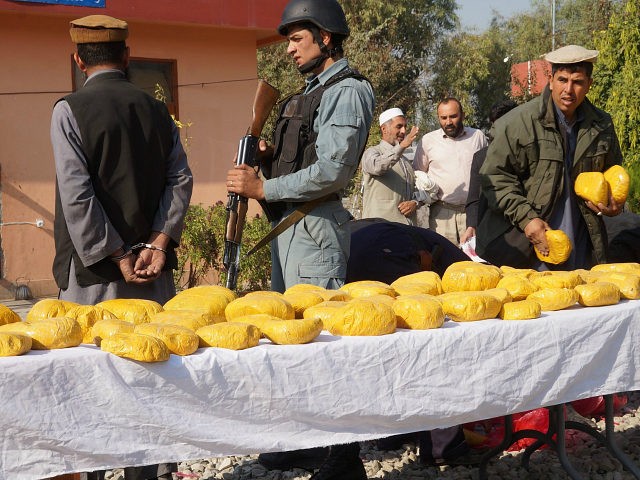President Donald Trump’s administration has resuscitated the U.S.-backed efforts to combat the deadly opium crop and its heroin derivative in Afghanistan, triggering an increase in interdiction and eradication activity after counternarcotics operations nearly disappeared over the last few years.
Data compiled by a U.S. watchdog agency shows the increase in counternarcotics activity.
Opium provides 60 percent of the Taliban terrorist group’s funding, according to the U.S. military.
Dr. Sebastian Gorka, a deputy assistant to President Trump in the office of the chief strategist at the White House, told Breitbart News that the administration is committed to combating the illicit opium business in Afghanistan and preventing terrorists from benefiting from it.
“We have great people in the administration whose explicit mission is to look at those issues,” said Gorka. “It’s not a simple problem to solve, but yeah it is very much part of our mission.”
Interdiction data shows that drug seizures involving opium have intensified under Trump’s watch, along with efforts to destroy poppy crops. U.S. funding for those operations has also increased by several hundred million dollars.
Notwithstanding that the illicit opium business reached historic levels of production in Afghanistan, the world’s top supplier of opium and heroin, there was a substantial hiatus in anti-drug efforts under former President Barack Obama.
Considered one of his first major Afghan war decisions after taking office in 2009, the former president oversaw the end of the main U.S.-led eradication effort, deciding instead to assist in anti-drug operations carried out by local and national law enforcement in the war-ravaged country.
By 2016, the latest year for which data is available, cultivation had increased about 10 percent to 201,000 hectares (ha) and potential production nearly 30 percent to 4.8 million kg, from the previous year’s totals.
Meanwhile, eradication activity dropped by more than 90 percent during the last year of the former administration when compared to 2015.
Security challenges, primarily fueled by the Taliban, have also hampered Afghan government drug control efforts backed by the United States.
Nevertheless, eradication activity has increased in the first few months of the Trump administration.
In its latest quarterly report to Congress, the U.S. Special Inspector General for Afghanistan Reconstruction (SIGAR) notes:
Eradication efforts began in March, and by May 23, Afghan authorities reported having eradicated 685 hectares in Balkh, Badghis, Herat, Kunar, Kabul, Kandahar, Laghman, Nangarhar, and Nimroz Provinces. This represents a marked increase over 2016 when only 355 hectares were eradicated.
SIGAR does note that the eradicated area is less than 1 percent of the total number of hectares under opium cultivation in Afghanistan.
Despite the increase in interdiction activity, some media reports and Afghan Ministry of Counter-Narcotics (MCN) officials have indicated that cultivation results this year will likely exceed the 2016 totals.
Meanwhile, drug seizures involving heroin, morphine, and opium have increased so far this fiscal year (October 1, 2016, to September 30, 2017), reports SIGAR.
There has been an increase of drugs seized despite a drop in the number of interdiction operations. In other words, less interdiction activity has yielded more results this year.
This year, U.S.-backed interdiction operations have yielded 21,593 kg of opium, nearly doubled the 10,487 kg seized last year.
There have also been 89,395 kg of morphine seized, an approximately 7-fold increase from the 13,041 kg interdicted in 2016.
Hashish seizures have almost doubled to 227,524 kg, compared to last year’s totals.
Heroin seizures did drop by nearly 50 percent to 1,809 kg, from 3,532 kg interdicted during all of 2016.
Opium is the main ingredient in heroin and morphine.
The opium-related seizures have only made a small dent to the 4.8 million kg of opium produced last year.
Last year, the illegal opium business generated $3.02 billion, nearly double the $1.56 billion in 2015, notes SIGAR, adding that “the value of opiates is worth more than two-thirds of the country’s entire licit agricultural sector.”
Trump officials have been forced to pick up the slack after the former administration placed a much-needed revision to the failed U.S. counternarcotics strategy on hold for more than two years.
Obama officials kicked the can down the road, postponing the approval of the revised strategy until the Trump administration took office.
The Trump team is still in the process of adopting the plan.
In July 2017, William Brownfield, the assistant secretary of State for the Bureau of International Narcotics and Law Enforcement Affairs (INL), met with Afghan President Ashraf Ghani to discuss the Trump administration’s plans to counter narcotics at the regional and global level.
The INL official asked the Afghan president for advice on the revised counternarcotics strategy
“Brownfield further stated that US President Donald Trump has a strong will in the fight against drugs and since Afghanistan is one of the biggest producers of drugs in the world, the strategy could have positive impact on Afghanistan,” noted the Afghan president’s office in a statement. “Meanwhile Ghani has welcomed US strategy to fight against drugs.”
Since the Afghan war began in October 2001, the U.S. has devoted about $8 billion to anti-drug operations.

COMMENTS
Please let us know if you're having issues with commenting.